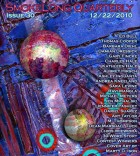Tell us about the title. The word “Jokes” is pretty loaded, and I generally avoid stories that read like jokes. These are called jokes but they don’t really read that way. So… tell us about that.
No, I suppose they don’t read like jokes in the way knock-knock jokes read, or bits by Buddy Hackett. I would say fragments of joke structure are still floating around in there. I like joke structure. Most jokes hinge around the number three, they’re precise and built like puzzles, every detail in some way ties in to each other. Good jokes hide their punch lines in plain sight. The best jokes always have a streak of sadness to them. “Three Jokes” has moments of mostly hopelessness that I can see myself in, and for some reason that makes me laugh.
Where did the inspiration come from for each of these mini-stories? And how did they come together into one flash?
Most my ideas come from watching and listening while walking to the store. Before leaving the apartment I check for keys, wallet, and a small notebook plus pen. With “Three Jokes,” I suppose each story came together by being in my head at the same time and lining up rather nicely. I liked the symmetry they made when arranged in a row, the asymmetry that appeared after forcing them into a single narrative.
The final images in each of these scenes stay with me. The final image of the first part is curious. Tell us about it — why they are trying to yawn.
I have a fondness for mannerisms, physical ticks and verbal malfunctions, the faces people make when they sneeze or yawn or think of something sour. Often, I’ll watch people and feel as if I’m in a Charlie Chaplin movie. Not sure why I find these little behaviors so interesting, perhaps because they’re often overlooked or written off as irrelevant, even though they’re happening all the time. I think the folks in the elevator are trying to yawn because it’s the only thing they can do and that made sense to me somehow. Also, the elevator is moving and so their ears are popping.
The final image of the last part is lovely – the last two sentences especially, are what sold me on this piece. Everything occurring will continue to occur. This could be seen as a positive thing or negative. Do you recall ever being stuck in a moment such as this?
That came from a video I saw, about a dog. I have a contentious relationship with dogs. On one hand, I dislike them very much. They’re almost always wet. On the other hand, I find them to be remarkably similar to people and, in some ways, weirdly relatable. The video showed a dog suffering from separation anxiety. Every time its owner left, the dog would literally eat up the house, convinced it had been abandoned forever. Usually, I don’t eat my pillow when the door closes to my apartment. But I could absolutely understand what was happening in the video: anger and frustration, being trapped by thought, wanting to control an uncontrollable situation. I liked the idea of this dog just eating and eating until it swallowed the whole house. It seemed so terrible to me, but also so celebratory.
According to your bio, you write flash fiction and run long distances. Do you find inspiration, or draft stories or vignettes in your head while running?
Yes. I get my best writing done while running. It shakes my brain up, gets my gears turning. There will be days when I feel stuck and go out for a run. Somewhere after mile two, the jam shakes loose and ideas start pouring in. Other times all I want is to turn my brain off. I’ll be out there for hours and not think of a thing. I feel best then; my mind at its least unfettered. Both writing and running require concentration and patience, they teach me how to sustain commitment to a single activity and effectively remain in my head for long bouts of time. What I learn from one I apply to the other. Often, I see them as the exact same thing. Or, at least, identical twins conjoined at the hip.


